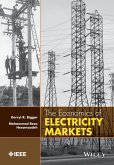

Alle Infos zum eBook verschenken

- Format: PDF
- Merkliste
- Auf die Merkliste
- Bewerten Bewerten
- Teilen
- Produkt teilen
- Produkterinnerung
- Produkterinnerung

Hier können Sie sich einloggen

Bitte loggen Sie sich zunächst in Ihr Kundenkonto ein oder registrieren Sie sich bei bücher.de, um das eBook-Abo tolino select nutzen zu können.
Bridges the knowledge gap between engineering and economics in a complex and evolving deregulated electricity industry, enabling readers to understand, operate, plan and design a modern power system With an accessible and progressive style written in straight-forward language, this book covers everything an engineer or economist needs to know to understand, operate within, plan and design an effective liberalized electricity industry, thus serving as both a useful teaching text and a valuable reference. The book focuses on principles and theory which are independent of any one market design.…mehr
- Geräte: PC
- mit Kopierschutz
- eBook Hilfe
- Größe: 6.44MB
![The Economics of Electricity Markets (eBook, ePUB) The Economics of Electricity Markets (eBook, ePUB)]() Darryl R. BiggarThe Economics of Electricity Markets (eBook, ePUB)99,99 €
Darryl R. BiggarThe Economics of Electricity Markets (eBook, ePUB)99,99 €![Electricity Markets (eBook, PDF) Electricity Markets (eBook, PDF)]() Jeremy LinElectricity Markets (eBook, PDF)113,99 €
Jeremy LinElectricity Markets (eBook, PDF)113,99 €![Modern Electricity Systems (eBook, PDF) Modern Electricity Systems (eBook, PDF)]() Vivek BhandariModern Electricity Systems (eBook, PDF)106,99 €
Vivek BhandariModern Electricity Systems (eBook, PDF)106,99 €![The Economics of Microgrids (eBook, PDF) The Economics of Microgrids (eBook, PDF)]() Amin KhodaeiThe Economics of Microgrids (eBook, PDF)96,99 €
Amin KhodaeiThe Economics of Microgrids (eBook, PDF)96,99 €![A New Swing-Contract Design for Wholesale Power Markets (eBook, PDF) A New Swing-Contract Design for Wholesale Power Markets (eBook, PDF)]() Leigh TesfatsionA New Swing-Contract Design for Wholesale Power Markets (eBook, PDF)127,99 €
Leigh TesfatsionA New Swing-Contract Design for Wholesale Power Markets (eBook, PDF)127,99 €![Sustainable Resource Development (eBook, PDF) Sustainable Resource Development (eBook, PDF)]() Gary M. ZatzmanSustainable Resource Development (eBook, PDF)186,99 €
Gary M. ZatzmanSustainable Resource Development (eBook, PDF)186,99 €![Managing Energy Risk (eBook, PDF) Managing Energy Risk (eBook, PDF)]() Markus BurgerManaging Energy Risk (eBook, PDF)90,99 €
Markus BurgerManaging Energy Risk (eBook, PDF)90,99 €-
-
-
Dieser Download kann aus rechtlichen Gründen nur mit Rechnungsadresse in A, B, BG, CY, CZ, D, DK, EW, E, FIN, F, GR, HR, H, IRL, I, LT, L, LR, M, NL, PL, P, R, S, SLO, SK ausgeliefert werden.
- Produktdetails
- Verlag: John Wiley & Sons
- Seitenzahl: 432
- Erscheinungstermin: 9. Juli 2014
- Englisch
- ISBN-13: 9781118775738
- Artikelnr.: 41209112
- Verlag: John Wiley & Sons
- Seitenzahl: 432
- Erscheinungstermin: 9. Juli 2014
- Englisch
- ISBN-13: 9781118775738
- Artikelnr.: 41209112
Introduction to Micro-economics 3 1.1 Economic Objectives 3 1.2
Introduction to Constrained Optimisation 5 1.3 Demand and Consumers'
Surplus 6 1.4 Supply and Producers' Surplus 10 1.5 Achieving Optimal
Short-Run Outcomes Using Competitive Markets 14 1.6 Smart Markets 17 1.7
Longer-Run Decisions by Producers and Consumers 20 1.8 Monopoly 22 1.9
Oligopoly 26 1.10 Summary 28 Questions 29 Further Reading 30 PART II
INTRODUCTION TO ELECTRICITY NETWORKS AND ELECTRICITY MARKETS 31 2
Introduction to Electric Power Systems 33 2.1 DC Circuit Concepts 33 2.2 AC
Circuit Concepts 36 2.3 Reactive Power 38 2.4 The Elements of an Electric
Power System 45 2.5 Electricity Generation 46 2.6 Electricity Transmission
and Distribution Networks 52 2.7 Physical Limits on Networks 60 2.8
Electricity Consumption 66 2.9 Does it Make Sense to Distinguish
Electricity Producers and Consumers? 67 2.10 Summary 70 Questions 71
Further Reading 72 3 Electricity Industry Market Structure and Competition
73 3.1 Tasks Performed in an Efficient Electricity Industry 73 3.2
Electricity Industry Reforms 76 3.3 Approaches to Reform of the Electricity
Industry 79 3.4 Other Key Roles in a Market-Orientated Electric Power
System 81 3.5 An Overview of Liberalised Electricity Markets 82 3.6 An
Overview of the Australian National Electricity Market 85 3.7 The Pros and
Cons of Electricity Market Reform 88 3.8 Summary 89 Questions 90 Further
Reading 90 PART III OPTIMAL DISPATCH: THE EFFICIENT USE OF GENERATION,
CONSUMPTION AND NETWORK RESOURCES 91 4 Efficient Short-Term Operation of an
Electricity Industry with no Network Constraints 93 4.1 The Cost of
Generation 93 4.2 Simple Stylised Representation of a Generator 96 4.3
Optimal Dispatch of Generation with Inelastic Demand 97 4.4 Optimal
Dispatch of Both Generation and Load Assets 102 4.5 Symmetry in the
Treatment of Generation and Load 104 4.6 The Benefit Function 105 4.7
Nonconvexities in Production: Minimum Operating Levels 106 4.8 Efficient
Dispatch of Energy-Limited Resources 108 4.9 Efficient Dispatch in the
Presence of Ramp-Rate Constraints 110 4.10 Startup Costs and the
Unit-Commitment Decision 113 4.11 Summary 115 Questions 116 Further Reading
117 5 Achieving Efficient Use of Generation and Load Resources using a
Market Mechanism in an Industry with no Network Constraints 119 5.1
Decentralisation, Competition and Market Mechanisms 119 5.2 Achieving
Optimal Dispatch Through Competitive Bidding 121 5.3 Variation in Wholesale
Market Design 123 5.4 Day-Ahead Versus Real-Time Markets 126 5.5 Price
Controls and Rationing 129 5.6 Time-Varying Demand, the Load-Duration Curve
and the Price-Duration Curve 133 5.7 Summary 135 Questions 137 Further
Reading 137 6 Representing Network Constraints 139 6.1 Representing
Networks Mathematically 139 6.2 Net Injections, Power Flows and the DC Load
Flow Model 141 6.3 The Matrix of Power Transfer Distribution Factors 145
6.4 Distribution Factors for Radial Networks 146 6.5 Constraint Equations
and the Set of Feasible Injections 147 6.6 Summary 151 Questions 152 7
Efficient Dispatch of Generation and Consumption Resources in the Presence
of Network Congestion 153 7.1 Optimal Dispatch with Network Constraints 153
7.2 Optimal Dispatch in a Radial Network 156 7.3 Optimal Dispatch in a
Two-Node Network 157 7.4 Optimal Dispatch in a Three-Node Meshed Network
159 7.5 Optimal Dispatch in a Four-Node Network 161 7.6 Properties of Nodal
Prices with a Single Binding Constraint 162 7.7 How Many Independent Nodal
Prices Exist? 163 7.8 The Merchandising Surplus, Settlement Residues and
the Congestion Rents 163 7.9 Network Losses 166 7.10 Summary 169 Questions
170 Further Reading 170 8 Efficient Network Operation 171 8.1 Efficient
Operation of DC Interconnectors 171 8.2 Optimal Network Switching 173 8.3
Summary 177 Questions 178 Further Reading 178 PART IV EFFICIENT INVESTMENT
IN GENERATION AND CONSUMPTION ASSETS 179 9 Efficient Investment in
Generation and Consumption Assets 181 9.1 The Optimal Generation Investment
Problem 181 9.2 The Optimal Level of Generation Capacity with Downward
Sloping Demand 183 9.3 The Optimal Mix of Generation Capacity with Downward
Sloping Demand 186 9.4 The Optimal Mix of Generation with Inelastic Demand
189 9.5 Screening Curve Analysis 191 9.6 Buyer-Side Investment 193 9.7
Summary 195 Questions 196 Further Reading 197 10 Market-Based Investment in
Electricity Generation 199 10.1 Decentralised Generation Investment
Decisions 199 10.2 Can We Trust Competitive Markets to Deliver an Efficient
Level of Investment in Generation? 201 10.3 Price Caps, Reserve Margins and
Capacity Payments 203 10.4 Time-Averaging of Network Charges and Generation
Investment 206 10.5 Summary 207 Questions 207 PART V HANDLING
CONTINGENCIES: EFFICIENT DISPATCH IN THE VERY SHORT RUN 209 11 Efficient
Operation of the Power System in the Very Short-Run 211 11.1 Introduction
to Contingencies 211 11.2 Efficient Handling of Contingencies 212 11.3
Preventive and Corrective Actions 213 11.4 Satisfactory and Secure
Operating States 215 11.5 Optimal Dispatch in the Very Short Run 216 11.6
Operating the Power System Ex Ante as though Certain Contingencies have
Already Happened 218 11.7 Examples of Optimal Short-Run Dispatch 219 11.8
Optimal Short-Run Dispatch Using a Competitive Market 223 11.9 Summary 229
Questions 230 Further Reading 230 12 Frequency-Based Dispatch of Balancing
Services 231 12.1 The Intradispatch Interval Dispatch Mechanism 231 12.2
Frequency-Based Dispatch of Balancing Services 232 12.3 Implications of
Ignoring Network Constraints when Handling Contingencies 233 12.4
Procurement of Frequency-Based Balancing Services 238 12.5 Summary 241
Questions 242 Further Reading 242 PART VI MANAGING RISK 243 13 Managing
Intertemporal Price Risks 245 13.1 Introduction to Forward Markets and
Standard Hedge Contracts 245 13.2 The Construction of a Perfect Hedge: The
Theory 249 13.3 The Construction of a Perfect Hedge: Specific Cases 252
13.4 Hedging by Customers 256 13.5 The Role of the Trader 259 13.6
Intertemporal Hedging and Generation Investment 263 13.7 Summary 264
Questions 265 14 Managing Interlocational Price Risk 267 14.1 The Role of
the Merchandising Surplus in Facilitating Interlocational Hedging 267 14.2
Interlocational Transmission Rights: CapFTRs 269 14.3 Interlocational
Transmission Rights: Fixed-Volume FTRs 271 14.4 Interlocational Hedging and
Transmission Investment 273 14.5 Summary 276 Questions 277 Further Reading
277 PART VII MARKET POWER 279 15 Market Power in Electricity Markets 281
15.1 An Introduction to Market Power in Electricity Markets 281 15.2 How Do
Generators Exercise Market Power? Theory 284 15.3 How do Generators
Exercise Market Power? Practice 289 15.4 The Incentive to Exercise Market
Power: The Importance of the Residual Demand Curve 292 15.5 The Incentive
to Exercise Market Power: The Impact of the Hedge Position of a Generator
295 15.6 The Exercise of Market Power by Loads and Vertical Integration 298
15.7 Is the Exercise of Market Power Necessary to Stimulate Generation
Investment? 300 15.8 The Consequences of the Exercise of Market Power 301
15.9 Summary 304 Questions 306 Further Reading 306 16 Market Power and
Network Congestion 307 16.1 The Exercise of Market Power by a Single
Generator in a Radial Network 307 16.2 The Exercise of Market Power by a
Single Generator in a Meshed Network 311 16.3 The Exercise of Market Power
by a Portfolio of Generators 313 16.4 The Effect of Transmission Rights on
Market Power 314 16.5 Summary 315 Questions 315 Further Reading 315 17
Detecting, Modelling and Mitigating Market Power 317 17.1 Approaches to
Assessing Market Power 317 17.2 Detecting the Exercise of Market Power
Through the Examination of Market Outcomes in the Past 318 17.3 Simple
Indicators of Market Power 322 17.4 Modelling of Market Power 330 17.5
Policies to Reduce Market Power 332 17.6 Summary 333 Questions 334 Further
Reading 334 PART VIII NETWORK REGULATION AND INVESTMENT 335 18 Efficient
Investment in Network Assets 337 18.1 Efficient AC Network Investment 337
18.2 Financial Implications of Network Investment 338 18.3 Efficient
Investment in a Radial Network 342 18.4 Efficient Investment in a Two-Node
Network 344 18.5 Coordination of Generation and Network Investment in
Practice 348 18.6 Summary 350 Questions 351 Further Reading 351 PART IX
CONTEMPORARY ISSUES 353 19 Regional Pricing and Its Problems 355 19.1 An
Introduction to Regional Pricing 355 19.2 Regional Pricing Without
Constrained-on and Constrained-off Payments 357 19.3 Regional Pricing with
Constrained-on and Constrained-off Payments 364 19.4 Nodal Pricing for
Generators/Regional Pricing for Consumers 367 19.5 Summary 369 Questions
370 Further Reading 370 20 The Smart Grid and Efficient Pricing of
Distribution Networks 371 20.1 Efficient Pricing of Distribution Networks
371 20.2 Decentralisation of the Dispatch Task 374 20.3 Retail Tariff
Structures and the Incentive to Misrepresent Local Production and
Consumption 377 20.4 Incentives for Investment in Controllable Embedded
Generation 380 20.5 Retail Tariff Structures 388 20.6 Declining Demand for
Network Services and Increasing Returns to Scale 390 20.7 Summary 393
Questions 395 References 397 Index 399
Introduction to Micro-economics 3 1.1 Economic Objectives 3 1.2
Introduction to Constrained Optimisation 5 1.3 Demand and Consumers'
Surplus 6 1.4 Supply and Producers' Surplus 10 1.5 Achieving Optimal
Short-Run Outcomes Using Competitive Markets 14 1.6 Smart Markets 17 1.7
Longer-Run Decisions by Producers and Consumers 20 1.8 Monopoly 22 1.9
Oligopoly 26 1.10 Summary 28 Questions 29 Further Reading 30 PART II
INTRODUCTION TO ELECTRICITY NETWORKS AND ELECTRICITY MARKETS 31 2
Introduction to Electric Power Systems 33 2.1 DC Circuit Concepts 33 2.2 AC
Circuit Concepts 36 2.3 Reactive Power 38 2.4 The Elements of an Electric
Power System 45 2.5 Electricity Generation 46 2.6 Electricity Transmission
and Distribution Networks 52 2.7 Physical Limits on Networks 60 2.8
Electricity Consumption 66 2.9 Does it Make Sense to Distinguish
Electricity Producers and Consumers? 67 2.10 Summary 70 Questions 71
Further Reading 72 3 Electricity Industry Market Structure and Competition
73 3.1 Tasks Performed in an Efficient Electricity Industry 73 3.2
Electricity Industry Reforms 76 3.3 Approaches to Reform of the Electricity
Industry 79 3.4 Other Key Roles in a Market-Orientated Electric Power
System 81 3.5 An Overview of Liberalised Electricity Markets 82 3.6 An
Overview of the Australian National Electricity Market 85 3.7 The Pros and
Cons of Electricity Market Reform 88 3.8 Summary 89 Questions 90 Further
Reading 90 PART III OPTIMAL DISPATCH: THE EFFICIENT USE OF GENERATION,
CONSUMPTION AND NETWORK RESOURCES 91 4 Efficient Short-Term Operation of an
Electricity Industry with no Network Constraints 93 4.1 The Cost of
Generation 93 4.2 Simple Stylised Representation of a Generator 96 4.3
Optimal Dispatch of Generation with Inelastic Demand 97 4.4 Optimal
Dispatch of Both Generation and Load Assets 102 4.5 Symmetry in the
Treatment of Generation and Load 104 4.6 The Benefit Function 105 4.7
Nonconvexities in Production: Minimum Operating Levels 106 4.8 Efficient
Dispatch of Energy-Limited Resources 108 4.9 Efficient Dispatch in the
Presence of Ramp-Rate Constraints 110 4.10 Startup Costs and the
Unit-Commitment Decision 113 4.11 Summary 115 Questions 116 Further Reading
117 5 Achieving Efficient Use of Generation and Load Resources using a
Market Mechanism in an Industry with no Network Constraints 119 5.1
Decentralisation, Competition and Market Mechanisms 119 5.2 Achieving
Optimal Dispatch Through Competitive Bidding 121 5.3 Variation in Wholesale
Market Design 123 5.4 Day-Ahead Versus Real-Time Markets 126 5.5 Price
Controls and Rationing 129 5.6 Time-Varying Demand, the Load-Duration Curve
and the Price-Duration Curve 133 5.7 Summary 135 Questions 137 Further
Reading 137 6 Representing Network Constraints 139 6.1 Representing
Networks Mathematically 139 6.2 Net Injections, Power Flows and the DC Load
Flow Model 141 6.3 The Matrix of Power Transfer Distribution Factors 145
6.4 Distribution Factors for Radial Networks 146 6.5 Constraint Equations
and the Set of Feasible Injections 147 6.6 Summary 151 Questions 152 7
Efficient Dispatch of Generation and Consumption Resources in the Presence
of Network Congestion 153 7.1 Optimal Dispatch with Network Constraints 153
7.2 Optimal Dispatch in a Radial Network 156 7.3 Optimal Dispatch in a
Two-Node Network 157 7.4 Optimal Dispatch in a Three-Node Meshed Network
159 7.5 Optimal Dispatch in a Four-Node Network 161 7.6 Properties of Nodal
Prices with a Single Binding Constraint 162 7.7 How Many Independent Nodal
Prices Exist? 163 7.8 The Merchandising Surplus, Settlement Residues and
the Congestion Rents 163 7.9 Network Losses 166 7.10 Summary 169 Questions
170 Further Reading 170 8 Efficient Network Operation 171 8.1 Efficient
Operation of DC Interconnectors 171 8.2 Optimal Network Switching 173 8.3
Summary 177 Questions 178 Further Reading 178 PART IV EFFICIENT INVESTMENT
IN GENERATION AND CONSUMPTION ASSETS 179 9 Efficient Investment in
Generation and Consumption Assets 181 9.1 The Optimal Generation Investment
Problem 181 9.2 The Optimal Level of Generation Capacity with Downward
Sloping Demand 183 9.3 The Optimal Mix of Generation Capacity with Downward
Sloping Demand 186 9.4 The Optimal Mix of Generation with Inelastic Demand
189 9.5 Screening Curve Analysis 191 9.6 Buyer-Side Investment 193 9.7
Summary 195 Questions 196 Further Reading 197 10 Market-Based Investment in
Electricity Generation 199 10.1 Decentralised Generation Investment
Decisions 199 10.2 Can We Trust Competitive Markets to Deliver an Efficient
Level of Investment in Generation? 201 10.3 Price Caps, Reserve Margins and
Capacity Payments 203 10.4 Time-Averaging of Network Charges and Generation
Investment 206 10.5 Summary 207 Questions 207 PART V HANDLING
CONTINGENCIES: EFFICIENT DISPATCH IN THE VERY SHORT RUN 209 11 Efficient
Operation of the Power System in the Very Short-Run 211 11.1 Introduction
to Contingencies 211 11.2 Efficient Handling of Contingencies 212 11.3
Preventive and Corrective Actions 213 11.4 Satisfactory and Secure
Operating States 215 11.5 Optimal Dispatch in the Very Short Run 216 11.6
Operating the Power System Ex Ante as though Certain Contingencies have
Already Happened 218 11.7 Examples of Optimal Short-Run Dispatch 219 11.8
Optimal Short-Run Dispatch Using a Competitive Market 223 11.9 Summary 229
Questions 230 Further Reading 230 12 Frequency-Based Dispatch of Balancing
Services 231 12.1 The Intradispatch Interval Dispatch Mechanism 231 12.2
Frequency-Based Dispatch of Balancing Services 232 12.3 Implications of
Ignoring Network Constraints when Handling Contingencies 233 12.4
Procurement of Frequency-Based Balancing Services 238 12.5 Summary 241
Questions 242 Further Reading 242 PART VI MANAGING RISK 243 13 Managing
Intertemporal Price Risks 245 13.1 Introduction to Forward Markets and
Standard Hedge Contracts 245 13.2 The Construction of a Perfect Hedge: The
Theory 249 13.3 The Construction of a Perfect Hedge: Specific Cases 252
13.4 Hedging by Customers 256 13.5 The Role of the Trader 259 13.6
Intertemporal Hedging and Generation Investment 263 13.7 Summary 264
Questions 265 14 Managing Interlocational Price Risk 267 14.1 The Role of
the Merchandising Surplus in Facilitating Interlocational Hedging 267 14.2
Interlocational Transmission Rights: CapFTRs 269 14.3 Interlocational
Transmission Rights: Fixed-Volume FTRs 271 14.4 Interlocational Hedging and
Transmission Investment 273 14.5 Summary 276 Questions 277 Further Reading
277 PART VII MARKET POWER 279 15 Market Power in Electricity Markets 281
15.1 An Introduction to Market Power in Electricity Markets 281 15.2 How Do
Generators Exercise Market Power? Theory 284 15.3 How do Generators
Exercise Market Power? Practice 289 15.4 The Incentive to Exercise Market
Power: The Importance of the Residual Demand Curve 292 15.5 The Incentive
to Exercise Market Power: The Impact of the Hedge Position of a Generator
295 15.6 The Exercise of Market Power by Loads and Vertical Integration 298
15.7 Is the Exercise of Market Power Necessary to Stimulate Generation
Investment? 300 15.8 The Consequences of the Exercise of Market Power 301
15.9 Summary 304 Questions 306 Further Reading 306 16 Market Power and
Network Congestion 307 16.1 The Exercise of Market Power by a Single
Generator in a Radial Network 307 16.2 The Exercise of Market Power by a
Single Generator in a Meshed Network 311 16.3 The Exercise of Market Power
by a Portfolio of Generators 313 16.4 The Effect of Transmission Rights on
Market Power 314 16.5 Summary 315 Questions 315 Further Reading 315 17
Detecting, Modelling and Mitigating Market Power 317 17.1 Approaches to
Assessing Market Power 317 17.2 Detecting the Exercise of Market Power
Through the Examination of Market Outcomes in the Past 318 17.3 Simple
Indicators of Market Power 322 17.4 Modelling of Market Power 330 17.5
Policies to Reduce Market Power 332 17.6 Summary 333 Questions 334 Further
Reading 334 PART VIII NETWORK REGULATION AND INVESTMENT 335 18 Efficient
Investment in Network Assets 337 18.1 Efficient AC Network Investment 337
18.2 Financial Implications of Network Investment 338 18.3 Efficient
Investment in a Radial Network 342 18.4 Efficient Investment in a Two-Node
Network 344 18.5 Coordination of Generation and Network Investment in
Practice 348 18.6 Summary 350 Questions 351 Further Reading 351 PART IX
CONTEMPORARY ISSUES 353 19 Regional Pricing and Its Problems 355 19.1 An
Introduction to Regional Pricing 355 19.2 Regional Pricing Without
Constrained-on and Constrained-off Payments 357 19.3 Regional Pricing with
Constrained-on and Constrained-off Payments 364 19.4 Nodal Pricing for
Generators/Regional Pricing for Consumers 367 19.5 Summary 369 Questions
370 Further Reading 370 20 The Smart Grid and Efficient Pricing of
Distribution Networks 371 20.1 Efficient Pricing of Distribution Networks
371 20.2 Decentralisation of the Dispatch Task 374 20.3 Retail Tariff
Structures and the Incentive to Misrepresent Local Production and
Consumption 377 20.4 Incentives for Investment in Controllable Embedded
Generation 380 20.5 Retail Tariff Structures 388 20.6 Declining Demand for
Network Services and Increasing Returns to Scale 390 20.7 Summary 393
Questions 395 References 397 Index 399







